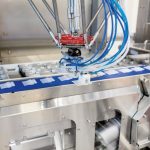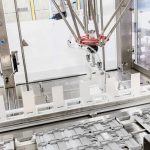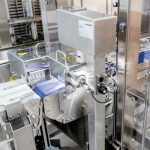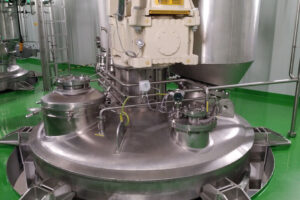The requirements of the project were difficult: the focus was on developing an automated solution, which could grow in various expansion stages with the rising production capacity. At the same time, the pack design had to be improved and the shelf life of the product extended. The ampoules were either to be packaged directly in a cardboard outer pack or folding carton, or as an alternative in a thermoformed pack made of aluminium multi-layer film, which was subsequently packed in a folding carton. The concept also had to include the possibility of inline labelling for product marking – as well as a further expansion stage, which would enable the products to be packed in plastic boxes as „product for stock“.
In the first phase, the packaging specialists at Multivac concentrated on systems for the infeed, alignment and converging of the products, as well as for the loading into folding cartons. The most demanding challenge for the experts, apart from the limited space available, was the fact that the filling process for eyedrops is a continuous process, which must not be interrupted if possible. Therefore they planned a buffer mode.
The second phase involved adding an R 245 thermoforming packaging machine, which had originally been planned in the initial line concept: this enabled the ampoules to be packed in aluminium multi-layer packs.
Reliable inspection
The ampoules are filled by means of Blow-Fill-Seal (BFS) technology, and they are then fed as non-oriented ampoules to the outer packaging line on transport conveyors. A Multivac vision system (MVS), which enables a wide range of detection and inspection tasks to be performed very precisely even at high speeds, is used to capture the orientation of the products and report their position to a handling module via the IPC control. This module orientates and places the products very accurately in an object carrier system. If any product faults are detected, these products are not gripped by the robot, but instead ejected from the line. As soon as three consecutive faulty products are identified, the line stops immediately.
The two-dimensional Data Matrix code for each individual ampoule is printed during filling, and it is checked for legibility and correctness by means of visual inspection. Here too any faulty products are separated out, and the line is stopped in the event of three fault messages.
The object carrier system
Thanks to the precise transfer of the ampoules into a counter-running object carrier system, the eyedrop ampoules are accurately aligned for the downstream processes such as labelling, thermoforming packaging and carton loading. Even at the start of the first phase, the object carrier system was designed so flexibly, that the pack cavities of the tray carrier can accommodate both the unpacked ampoules and those that are packaged in the thermoformed aluminium multi-layer packs.
The format of the object carrier system was consciously tailored to that of the thermoforming packaging machine. The H 242 handling module with its two 4-axis robots picks up three strips one after the other, before placing these in the object carrier in one step. The object carrier is then transported via transport conveyors to either the carton loading process or alternatively the thermoforming packaging process, after which they go onto carton loading.
The optional packaging process
If the eyedrop ampoules require to be packaged in aluminium multi-layer packs on the R 245 thermoforming packaging machine, they are transported away from the BFS line via a transport conveyor, before being placed in the object carrier system by a handling module. There they can be labelled horizontally if required. After labelling has been completed, the ampoules are automatically removed from the object carrier and loaded into the pack cavities of the thermoforming packaging machine. The strips are packaged, picked up automatically and placed in the object carrier system. The carrier system takes them to the outer packaging station, where they are packed into the folding cartons.
The cartonning process
Here the folding carton is erected and adhered with hot glue. A dispenser dispenses the pack leaflet. The folding carton and pack leaflet are pre-printed with a code, which is stored in the IPC of the H 242. If the codes are correct, the folding carton is transported onwards, after the leaflet has been placed in the carton by a dispensing arm.
The task of loading the products into the folding cartons is performed by the highly flexible H 242 handling module. Either two unpackaged strips at once or one aluminium multi-layer pack are picked up and placed in the folding carton. After the folding carton has been filled, it is sealed automatically with hot glue and then weighed. Only correctly filled folding cartons get to the downstream process, where they can be supplied either unbundled or bundled (by means of a banderole or completely shrink wrapped) using a banderoling machine, depending on the requirements of the end customer. A transport conveyor takes the cartons to a box packer and palletising unit.
Buffer mode
The packaging specialists at Multivac envisaged a buffer mode with two buffer units from the very start. This was also important in the first phase for the upstream machine, which is not allowed to be stopped if, for example, a downstream labeller breaks down. The filled object carriers are buffered in the first unit. As soon as a loaded object carrier gets to the first buffer, an empty object carrier is fed from the second buffer unit, since it is designed as a closed system. A light barrier is used to ensure in advance that the fed object carriers are actually empty.
Options for optimising the system
The entire system is designed to be so open in its design and control technology that even additional functions can easily be integrated, such as for example dispensing a label with an inline labeller. To achieve this however, the very small products must be positioned exactly in the object carriers – one of the biggest challenges for the handling module.
Another important option for the customer was the „white stock“ solution, by which the printed products are automatically placed in plastic boxes. These then go into storage. Reason: The market sometimes requires the ampoules to undergo quality control in the form of leak testing, which can only take place after a certain time has elapsed from the filling of the eyedrops. This means that the ampoules in their boxes must be stored in a warehouse at defined temperature and humidity conditions. After the ampoules have been successfully tested, they go back again into the packaging process.
Another aspect, which had to be taken into account, was secure line clearance, since the different production batches must be kept entirely separate. Multivac integrated an inspection solution into the line for this purpose. The focus was on complete process reliability in the linking and control of all components.
Multivac Sepp Haggenmüller SE & Co. KG, Wolfertschwenden
Author Dr. Thomas Kafka
Product & Business Development Manager, Medical, Pharma & Consumer Solutions,
Multivac












